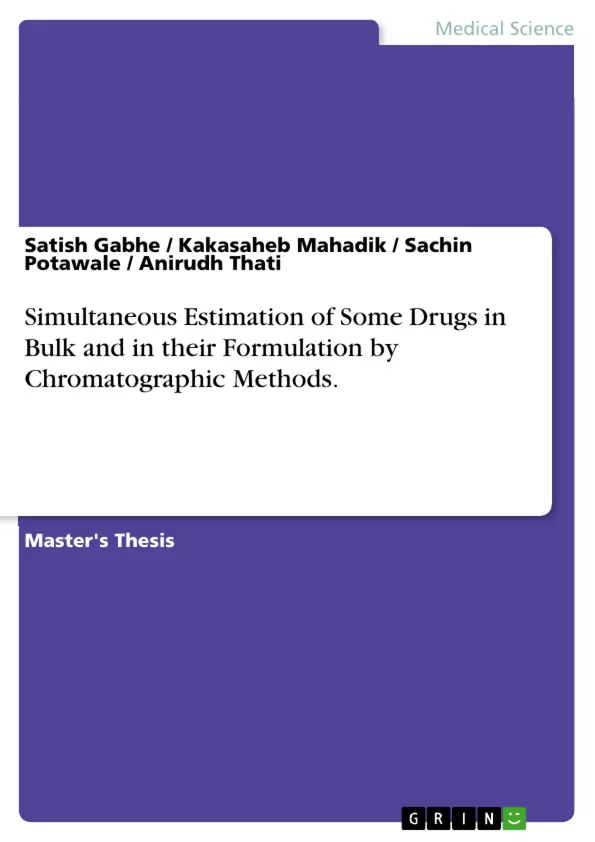A number of new drug entities, modifications of existing ones, and multi-component formulations are entering the market, every year. Development of simple analytical methods for analysis of various drugs in multi - component formulations is a tricky task for an analytical researcher. As analytical techniques are used throughout drug development, manufacturing, release of drug products, the reliability of their results is essential. Chromatographic methods are most useful and powerful techniques for qualitative and quantitative determination of drug/s. Therefore, appropriate validation to demonstrate the performance and suitability of the analytical method is much more than a formal requirement. Hence, there is need to develop and validate correct analytical method for these medicine/s.
This book details,
- Development and validation of HPTLC - densitometric method for concurrent estimation of metformin hydrochloride, pioglitazone hydrochloride and gliclazide in combined dosage form.
- Development and validation of HPTLC method for simultaneous estimation of moxifloxacin hydrochloride and dexamethasone sodium phosphate in combined pharmaceutical dosage form.
- Development and validation of RP - HPLC method for simultaneous estimation of ciprofloxacin hydrochloride and dexamethasone in combined dosage form, which is better alternative to existing one.
The developed analytical methods are simple, selective, accurate, robust, and precise with shorter analysis time for the analysis of drug/s in combined pharmaceutical dosage forms. All the developed HPTLC and HPLC methods have been validated as per ICH Q2 (R1) guidelines. Developed analytical methods could boost analytical researcher to work more efficiently in the field of analytical method development and validation of Pharmaceutical dosage forms.
Inhaltsverzeichnis (Table of Contents)
- Introduction
- Introduction to analytical chemistry
- Drug Profile
- Aims and Objectives
- Plan of Work
- Results and Discussion
- Experimental
- References
Zielsetzung und Themenschwerpunkte (Objectives and Key Themes)
This book aims to develop and validate simple, accurate, and robust analytical methods for the simultaneous estimation of various drugs in multi-component pharmaceutical formulations using chromatographic techniques. The methods are intended to be more efficient and cost-effective than existing methods.
- Development of HPTLC and HPLC methods for the simultaneous estimation of multiple drugs in combined dosage forms.
- Validation of the developed analytical methods according to ICH Q2 (R1) guidelines.
- Application of the methods for the analysis of drugs in bulk and in their formulations.
- Comparison of the developed methods with existing analytical methods.
- Contribution to the advancement of analytical research in the field of pharmaceutical dosage forms.
Zusammenfassung der Kapitel (Chapter Summaries)
The book begins with an introduction to analytical chemistry, highlighting the importance of developing accurate and reliable methods for drug analysis. Chapter 2 provides a detailed drug profile of the various compounds analyzed in the following chapters. The third chapter outlines the aims and objectives of the research, while chapter 4 discusses the planned work and methodology. The main results and discussions are presented in Chapter 5. Finally, the book includes information about the experimental procedures used in the study and a comprehensive list of references.
Schlüsselwörter (Keywords)
This book focuses on the development and validation of chromatographic methods for simultaneous estimation of drugs in bulk and their formulations. Key topics include HPTLC, HPLC, drug analysis, pharmaceutical dosage forms, validation, ICH Q2 (R1) guidelines, and analytical method development.
- Citar trabajo
- Dr. Satish Gabhe (Autor), Dr. Kakasaheb Mahadik (Autor), Sachin Potawale (Autor), Anirudh Thati (Autor), 2013, Simultaneous Estimation of Some Drugs in Bulk and in their Formulation by Chromatographic Methods., Múnich, GRIN Verlag, https://www.grin.com/document/272088



